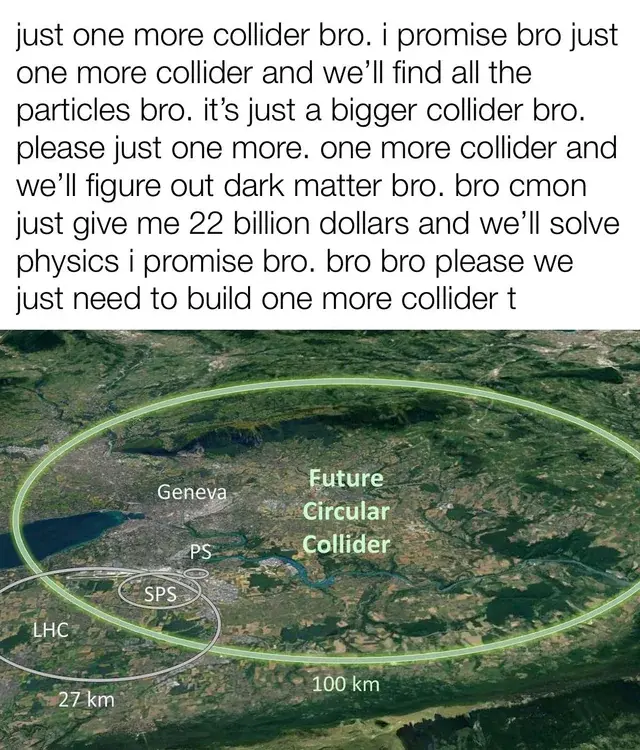this post was submitted on 08 Nov 2023
1682 points (95.3% liked)
Science Memes
11581 readers
1139 users here now
Welcome to c/science_memes @ Mander.xyz!
A place for majestic STEMLORD peacocking, as well as memes about the realities of working in a lab.

Rules
- Don't throw mud. Behave like an intellectual and remember the human.
- Keep it rooted (on topic).
- No spam.
- Infographics welcome, get schooled.
This is a science community. We use the Dawkins definition of meme.
Research Committee
Other Mander Communities
Science and Research
Biology and Life Sciences
- !abiogenesis@mander.xyz
- !animal-behavior@mander.xyz
- !anthropology@mander.xyz
- !arachnology@mander.xyz
- !balconygardening@slrpnk.net
- !biodiversity@mander.xyz
- !biology@mander.xyz
- !biophysics@mander.xyz
- !botany@mander.xyz
- !ecology@mander.xyz
- !entomology@mander.xyz
- !fermentation@mander.xyz
- !herpetology@mander.xyz
- !houseplants@mander.xyz
- !medicine@mander.xyz
- !microscopy@mander.xyz
- !mycology@mander.xyz
- !nudibranchs@mander.xyz
- !nutrition@mander.xyz
- !palaeoecology@mander.xyz
- !palaeontology@mander.xyz
- !photosynthesis@mander.xyz
- !plantid@mander.xyz
- !plants@mander.xyz
- !reptiles and amphibians@mander.xyz
Physical Sciences
- !astronomy@mander.xyz
- !chemistry@mander.xyz
- !earthscience@mander.xyz
- !geography@mander.xyz
- !geospatial@mander.xyz
- !nuclear@mander.xyz
- !physics@mander.xyz
- !quantum-computing@mander.xyz
- !spectroscopy@mander.xyz
Humanities and Social Sciences
Practical and Applied Sciences
- !exercise-and sports-science@mander.xyz
- !gardening@mander.xyz
- !self sufficiency@mander.xyz
- !soilscience@slrpnk.net
- !terrariums@mander.xyz
- !timelapse@mander.xyz
Memes
Miscellaneous
founded 2 years ago
MODERATORS
you are viewing a single comment's thread
view the rest of the comments
view the rest of the comments

Dont worry dude, I won't. I promise. 😆
Well, I understand the argument for terraforming, and I'd bet good money we will terraform it long before disassembly, but I'm more of an O'Neil Cylinder / Dyson Swarm kind of guy. I prefer the idea of overwhelming surface area via orbital habitats rather than colonizing gravity wells. I also don't trust Venus not to catastrophically resurface itself and refill the atmosphere with CO2 and sulphuric acid in a mass volcanic event.
Long term, but far too soon the Sun will expand into a red giant and devour Mercury, Venus, and likely Earth as well. If it's possible to employ a Dyson Swarm to lift material from a star to reduce its mass, then it may be feasible to prevent or mitigate the red giant phase to preserve Earth and extend its habitability, perhaps indefinitely. If preserving the birthplace of known life seems more important than building a copy in a more precarious orbit, then we ought to sacrifice that copy to expand the Dyson Swarm and mine the Sun faster. Mercury first though. We've got time. Mars can probably go too.
Oh yes, and if the notion of slowly altering Earth's orbit by tossing asteroids past us ever needs to happen, then surely rapid firing 2 or 3 planets worth of material across our bow ought to get the job done much faster.
Considering the eons involved with stripping both inward planets down to the last bucketful though, I'm certainly in favor of a few millennia to fully explore and research them both beforehand.
A properly configured solar thruster doubles as a starlifting platform. Kurzgesagt has a video on is as well as PBS Spacetime